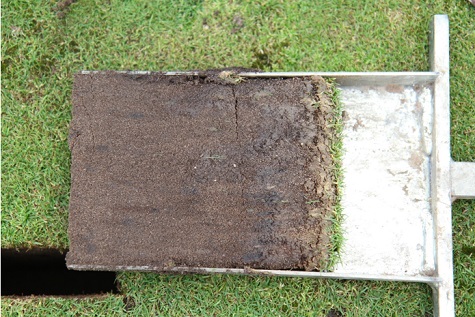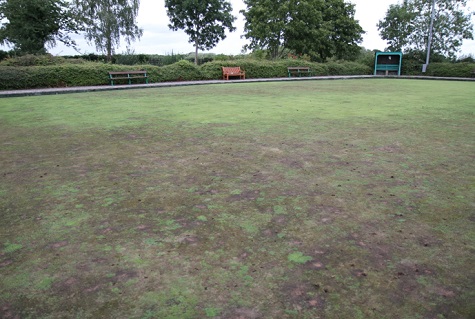The months of September and October are a busy time for turf professionals and volunteers with both cricket, and bowls clubs destined to complete the work before temperatures drop below single figures or the weather turns too unfavourable to undertake the work.
In essence the renovation gives them the opportunity to remove unwanted thatch, restore levels and re-populate with some fresh seed.
It is surprising how quickly thatch layers can build up. I recently consulted on a bowling green in Shropshire that had over 75mm of thatch on their green.
The main concerns of the club were the deterioration of the green’s playing surface and the problem of birds feeding and damaging the turf. The bird damage had been going on since June.
I asked a number of questions regarding the current maintenance regimes of the green, a timeline of when these problems started and what previous work at been carried out on the green, in terms of annual maintenance and previous end of season renovations. I also took several core samples that enabled a physical examination of the soil and sward profile of the green.

Essentially the conclusion from the discussions and inspection of the green, was that there was a deep seated thatch problem across the whole green, with thatch layers in excess of 50mm with very little rooting below 80-100mm.
Thatch is the intermingled layer of living and dead stems, leaves, and roots that exist between the soil and green vegetation. A thin thatch layer (3-8mm) provides some benefits such as surface cushioning, increased wear tolerance, and temperature moderation. Excessive thatch (20mm or more) can cause a variety of problems.
Excessive thatch problems :-
- Prevents water and air from reaching the soil and root zone, thus reducing the turf's tolerance to drought and temperature extremes.
- Provides a protective home for insect pests and disease fungi.
- Prevents certain insecticides and herbicides from penetrating the soil level, making them ineffective.
- Acts as a sponge and creates an anaerobic layer which affects plant growth
- Affects root depth
Thatch layers seen in several samples taken were more than 50mm in depth - a substantial layer of thatch that combined with some over-watering issues was probably causing the current surface and playability issues the club are experiencing.
This has been compounded by the fact that there seems to be a leatherjacket problem with birds feeding on larvae that have been seen in and on the green. The thatch layer is providing an ideal home and food source for leatherjacket larvae.
I also noticed that the watering system was not working efficiently, with some signs of overwatering of three areas of the green that was evident by the fact that the sward in these areas was in poor health, saturated and dying back due to anaerobic conditions seen in the top 50mm of the sward - probably acerbated by the deep layers of thatch seen in these areas of the green.

As for general maintenance of the green, it would seem from conversations with club members there has been a lack of regular maintenance regarding controlling thatch levels.
No scarifying and verticutting work has been carried out on the green for the last two years. This has certainly been the catalyst for the build-up of this thatch layer and is the key issue leading to the current problems and state of the green.
Recommendations
The club’s first priorities are to reduce the deep-seated thatch layers by carrying out some effective renovation works, followed by a more intense set of maintenance regimes during the growing season to help promote some improved healthy grass growth and root depth.
Work needs to start this September with a thorough end of season renovation programme of work that should include the following activities:
- Deep scarification of the green in at least three directions, using a tractor mounted powered scarifier
- Aeration of the green using either a pedestrian or tractor mounted solid tine spiker that can penetrate to a depth of between 100mm-200mm.
- Top dressing with 3 tonne of 70/30 rootzone material to restore levels and provide a seed bed for two 20 KG bags of bowling green fescue / ryegrass seed mixture.
- Drag matting/ brushing in top dressing
- Applying two 25/ KG bags of autumn granular NPK fertiliser
This end of season work (September 2022) is only the start of the work needed to rectify the current problems seen on the green. It is likely to take at least two years of essential maintenance operations focussing on some regular verticutting and aeration work to help reduce these thatch layers combined with further end of season work to help reduce these layers to an acceptable level below 6mm.

However, there are alternative operations that will effectively fix the problem straight away - and that is to have the existing vegetation taken off, Vertidrained to de-compact subsoil layers, laser graded to reform levels / contours and reseeded.
Option 1 is the use of a 1.2 m wide fraise mower that is to plane off in 25mm layers the thatch material until it is removed, cultivate and surface restore levels and reseed. Or the other method is to have a complete reconstruction of the green’s playing surface.
However, they need to be planned and be mindful that there may be a delay in when the green will be playable the following season, depending on how quickly the new seeded green becomes established.
Typical costs of these end of season renovations will vary dependant on the amount of work completed.
A general scarification, top dressing and overseeding of the green as outlined in this article will cost in the region of £1200- £3000, depending on whether you do the work yourselves or you get a contractor in.
The likely cost of the materials will set you back the best part of £1200. As for the other works mentioned, fraise mowing the green could be in the region of £5000 and a complete reconstruction of the playing surface around £20,000.
At the end of the day there will always be costs involved for the maintenance and renovation of a bowling green.